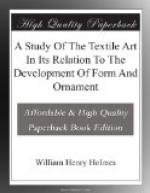[Illustration: FIG. 330. Ornament produced by wrapping certain light fillets with darker ones before weaving. Mexican work.]
[Illustration: FIG. 331. Ornamental effect secured by weaving in series of dark fillets, forming a superficial device. Work of the Klamath Indians.]
[Illustration: FIG. 332. Baskets ornamented with feather work. Northwest coast tribes—1/4.]
[Illustration: FIG. 333. Baskets ornamented with feather work. Northwest coast tribes—1/4.]
An example from a higher grade of art will be of value in this connection. The ancient Peruvians resorted to many clever devices for purposes of enrichment. An illustration of the use of extra-constructional means to secure desired ends are given in Figs. 334 and 335. Threads constituting a supplemental warp and woof are carried across the under side of a common piece of fabric, that they may be brought up and woven in here and there to produce figures of contrasting color upon the right side. Fig. 334 shows the right side of the cloth, with the secondary series appearing in the border and central figure only. Fig. 335 illustrates the opposite side and shows the loose hanging, unused portions of the auxiliary series. In such work, when the figures are numerous and occupy a large part of the surface, the fabric is really a double one, having a dual warp and woof. Examples could be multiplied indefinitely, but it will readily be seen from what has been presented that the results of these extraordinary means cannot differ greatly from those legitimately produced by the fundamental filaments alone.
[Illustration FIG. 334. Piece of cotton cloth showing the use of a supplementary web and woof. Ancient Peru.]
[Illustration FIG. 335. Piece of cotton cloth showing the use of a supplementary web and woof. Ancient Peru.]
Superconstructive features.—In reviewing the superconstructive decorative features in the preceding section I classified them somewhat closely by method of execution or application to the fabric, as stitched, inserted, drawn, cut, applied, and appended. It will be seen that, although these devices are to a great extent of the nature of needlework, all cannot be classed under this head.
Before needles came into use the decorative features were inserted and attached in a variety of ways. In open work nothing was needed but the end of the fillet or part inserted; again, in close work, perforations were made as in leather work, and the threads were inserted as are the waxed ends of the shoemaker.
The importance of this class of decorative devices to primitive peoples will be apparent if we but call to mind the work of our own Indian tribes. What a vast deal of attention is paid to those classes of embroideries in which beads, feathers, quills, shells, seeds, teeth, &c., are employed, and to the multitude of novel applications of tassels, fringes, and tinkling pendants. The taste for these things is universal and their relation to the development of esthetic ideas is doubtless very intimate.




